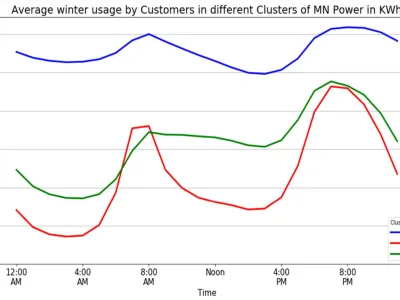CUB partners with Minnesota Power to analyze bill impacts of proposed rate designs

Published December 7, 2020
This month, CUB and Minnesota Power released the findings of joint research evaluating how real customers’ electricity bills would change under four new rate designs that are under consideration.
Over the past several years, Minnesota Power (“MP”) has engaged in a pilot program, stakeholder discussions, and regulatory processes to assess whether it should transition to a new means of charging customers for energy usage. CUB has been an active participant in stakeholder discussions and PUC filings surrounding this issue. We were pleased to recently partner with Minnesota Power and CUB-Illinois to conduct a statistical analysis assessing the effects such a transition would have on MP’s customers. We finalized a report summarizing the findings derived from that analysis earlier this month. Minnesota Power included the report as an exhibit in a compliance filing made with the Public Utilities Commission on December 1, 2020.
Minnesota Power’s current and proposed rates
Currently, Minnesota Power uses an inclining block rate (“IBR”), a rate that increases as a customer’s monthly energy usage exceeds certain thresholds. A customer’s first block of energy usage is the least expensive, and the price of electricity goes up as the customer uses more. At the PUC’s direction, Minnesota Power is now considering transitioning to a flat rate or a time-of-day (“TOD”) rate. Under a flat rate, customers would pay the same rate per unit of electricity regardless of when or how much energy is consumed. Under a TOD rate, customers would pay different rates depending on the time of day the energy is used — the rate is higher during high-demand periods (early evening) and lower during low-demand periods (overnight).
Under Minnesota Power’s current IBR rate structure, customers who use a lot of electricity end up with very high bills, because the price per unit of electricity goes up the more you use. Conversely, people who use little electricity have bills that are quite low.
Studies – and the experience of low-income service providers such as Energy CENTS Coalition, which also participated in the Company’s stakeholder discussions – suggest that low-income households are more likely than an average customer to use less energy, and therefore to benefit from the Company’s current IBR structure. With that in mind, Energy CENTS Coalition, CUB, and other stakeholders expressed concern that transitioning away from an IBR structure could cause low-income customers’ bills to increase.
To address this, Minnesota Power proposed including a discount for low-income customers who use relatively little energy as a part of the flat and TOD rates it is considering. After an initial transition period, customers would be eligible for the discount if: (1) they receive low-income energy assistance or if they self-declare that they are low-income and (2) they use less than 1,000 kWh of electricity in an average month.
Research methodology
Minnesota Power partnered with the Citizens Utility Boards of Minnesota and Illinois to assess the impact the proposed flat or TOD rates would have on customers’ bills. Minnesota Power shared with the CUB team hourly energy usage data for approximately 41,900 anonymous residential customers. The data analysis team at CUB-IL then applied an algorithm to that data to “cluster” three sub-sets of customers according to their energy usage patterns. (A more detailed explanation of our methodology is included in the report, itself.) Using these methods, we were able to draw conclusions about how the proposed rates will impact different customers’ bills.
Findings
In summary, our study suggests that if Minnesota Power transitions away from its current IBR rate design to a flat rate with the low-income, low-use discount or to a TOD rate with the low-income, low-use discount, the majority of the Company’s residential customers would see bill increases, while a smaller percentage of such customers would realize savings. Almost every low-income customer receiving funding from the Low Income Home Energy Assistance Program (LIHEAP, also known as energy assistance) would see their bills decrease. Such customers would save money, either because (1) they are eligible for the low-income, low-use discount, or (2) they currently use enough energy to see a natural benefit from moving away from the current IBR design.
The below chart illustrates how a transition from IBR to a flat rate would affect LIHEAP participants (low-income customers receiving energy assistance) vs. non-LIHEAP participants.
Similarly, the below charts illustrate how a transition from an IBR to one of three proposed TOD rates would affect LIHEAP participants vs. non-LIHEAP participants.
LIHEAP Participants Non-LIHEAP ParticipantsWe are pleased to have had the opportunity to work directly with one of Minnesota’s largest utilities in this way. This partnership exemplifies the type of work CUB had in mind when proposing that the Commission require utilities to make anonymized or aggregated energy-usage data more available to academic institutions and non-profit organizations like CUB. Now that the Commission approved CUB’s data access proposal to move forward, we look forward to conducting similar analyses that inform our efforts to help protect consumers and serve the public interest.